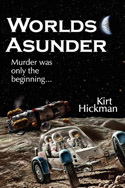by Kirt Hickman
 A picture is worth a thousand words (pardon the cliché, but it’s true). Good fiction draws the reader away from his mundane life and transports him to a world of wonder wholly different from his own. Whether this difference is physical, cultural, psychological, or situational, metaphors and similes can help bring your fictional world to life.
A picture is worth a thousand words (pardon the cliché, but it’s true). Good fiction draws the reader away from his mundane life and transports him to a world of wonder wholly different from his own. Whether this difference is physical, cultural, psychological, or situational, metaphors and similes can help bring your fictional world to life.
Description
When you use these comparisons, you draw a mental picture that relates an element of your story to something within the reader’s realm of experience. In the following example, several characters in my science fiction novel, Worlds Asunder, cross an open expanse of the Moon’s surface.
…the four of them made a dash for the building. They ran side by side. In the Moon’s gravity, they rose slowly with each stride and returned to the ground just as slowly, only to bounce again and again until they reached their destination.
This passage contains a detailed description of how my characters run in low gravity. It tries to invoke an image that will bring my setting to life and show how the Moon is different from Earth. The problem is, I’ve used so many words that by the time the reader gets to the end of the description, he no longer cares about the image. He just wants to get on with the story. Comparing the characters’ motion to something familiar can invoke the desired image more clearly, and with fewer words, than literal description:
…the four of them made a dash for the building, bounding up and down in a ragged line, like so many horses on a merry-go-round.
Taking the merry-go-round out of context, putting it on the Moon, and using it to describe running makes the comparison unexpected. I’ve used a familiar object to show how my setting differs from the reader’s here and now.
Yet I can improve the passage further. The word “building” lacks description. How big is this building? What does it look like? I’ve missed an opportunity to remind the reader that I’ve taken him to another world. In an earlier scene, I described the building like this:
The habitation dome was maybe a hundred meters in diameter with the semi-cylindrical protrusion of the equipment garage on one side, the only obvious entrance to the structure.
Can you picture the building? What if I add this sentence:
From afar, it looked like a giant igloo on a vast stretch of dirty ice.
The comparison solidifies the image. In Worlds Asunder, I refer back to this description in the merry-go-round scene by changing the word “building” to “igloo”:
…the four of them made a dash for the igloo, bounding up and down in a ragged line, like so many horses on a merry-go-round.
Emotion
You can use comparisons to invoke emotion. The following passage describes the wreckage of a crashed space ship:
…the fuselage came into view, jutting skyward from the flat terrain, surrounded by sparkling debris.
Perhaps this invokes an image, but a couple of well-drawn comparisons will enhance the emotional impact.
…the fuselage came into view, jutting skyward from the flat terrain like a solitary tombstone in a garden of glittering metal.
When the fuselage becomes a tombstone in a garden, it forms the emotional image of death. It reminds the reader of something he already knows: a body lies here, probably inside the fuselage. The viewpoint character is approaching a grave.
Viewpoint
Comparisons can express an idea or a character’s viewpoint more effectively than direct narrative.
…a tremendous pop reverberated through the cavernous hangar from the huge doors in front of the cockpit window. The squeal of the unused rollers filtered into the cabin like a scream of protest against this change in military posture…
This passage doesn’t specify what the change in military posture is. Nevertheless, when I use “scream of protest” to describe a simple sound, I don’t have to tell the reader how the viewpoint character feels about the change.
Use Comparisons Carefully
Look for opportunities to use comparisons in your fiction, but don’t overdo it. A well-placed comparison that invokes the right image, at the right time, will enrich your story. But if every paragraph contains one, you’ll force too many unrelated images upon the reader. Your own world will get lost among them.
Beware misused, imprecise, or cliché comparisons. Misused or imprecise comparisons can confuse your reader, and cliché comparisons will have no emotional impact.
 Kirt Hickman is a technical writer turned fiction author. His books include three sci-fi thriller novels Worlds Asunder (2008), Venus Rain (2010) and Mercury Sun (2014), the high fantasy novel Fabler’s Legend (2011), and the writers’ how-to Revising Fiction: Making Sense of the Madness (2009).
Kirt Hickman is a technical writer turned fiction author. His books include three sci-fi thriller novels Worlds Asunder (2008), Venus Rain (2010) and Mercury Sun (2014), the high fantasy novel Fabler’s Legend (2011), and the writers’ how-to Revising Fiction: Making Sense of the Madness (2009).
This article was originally published in the February 2008 issue of SouthWest Sage, and is reprinted here by permission of the author.


























[…] WHAT THE RIGHT COMPARISON CAN DO FOR YOUR STORY […]